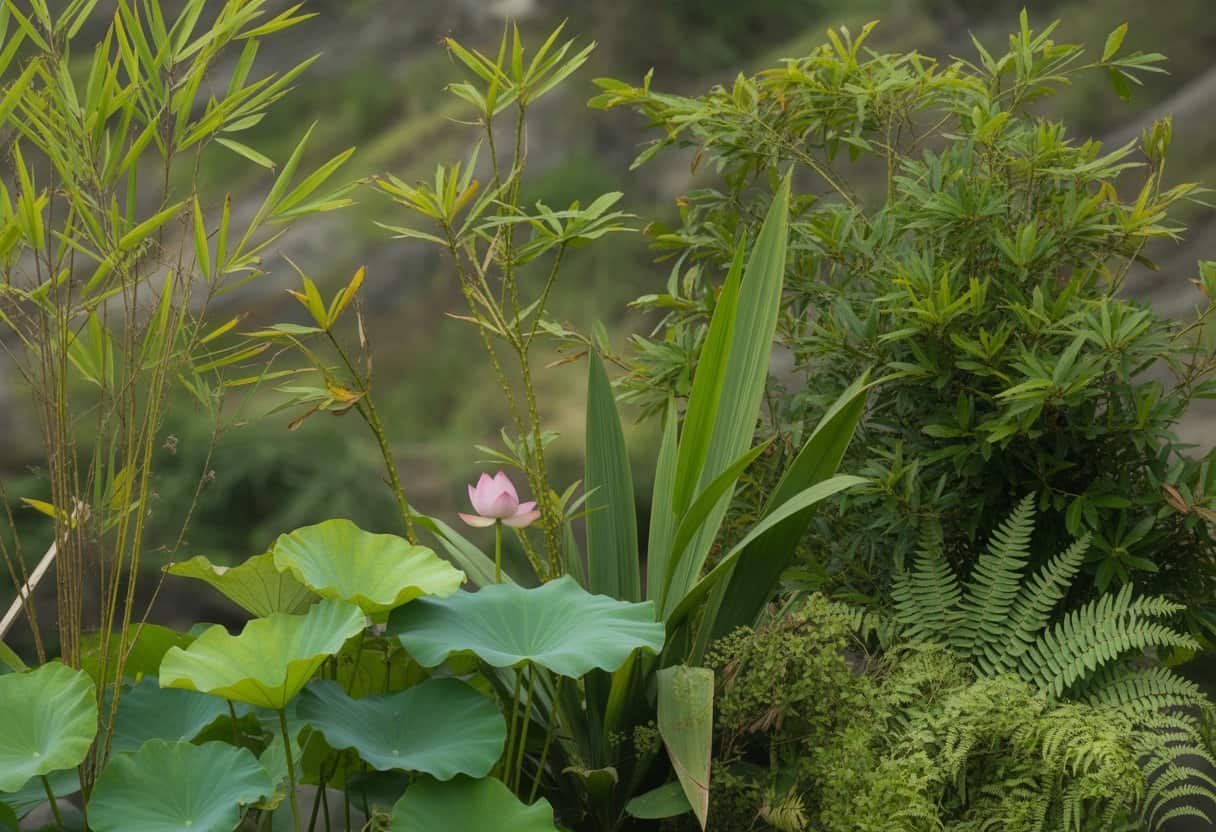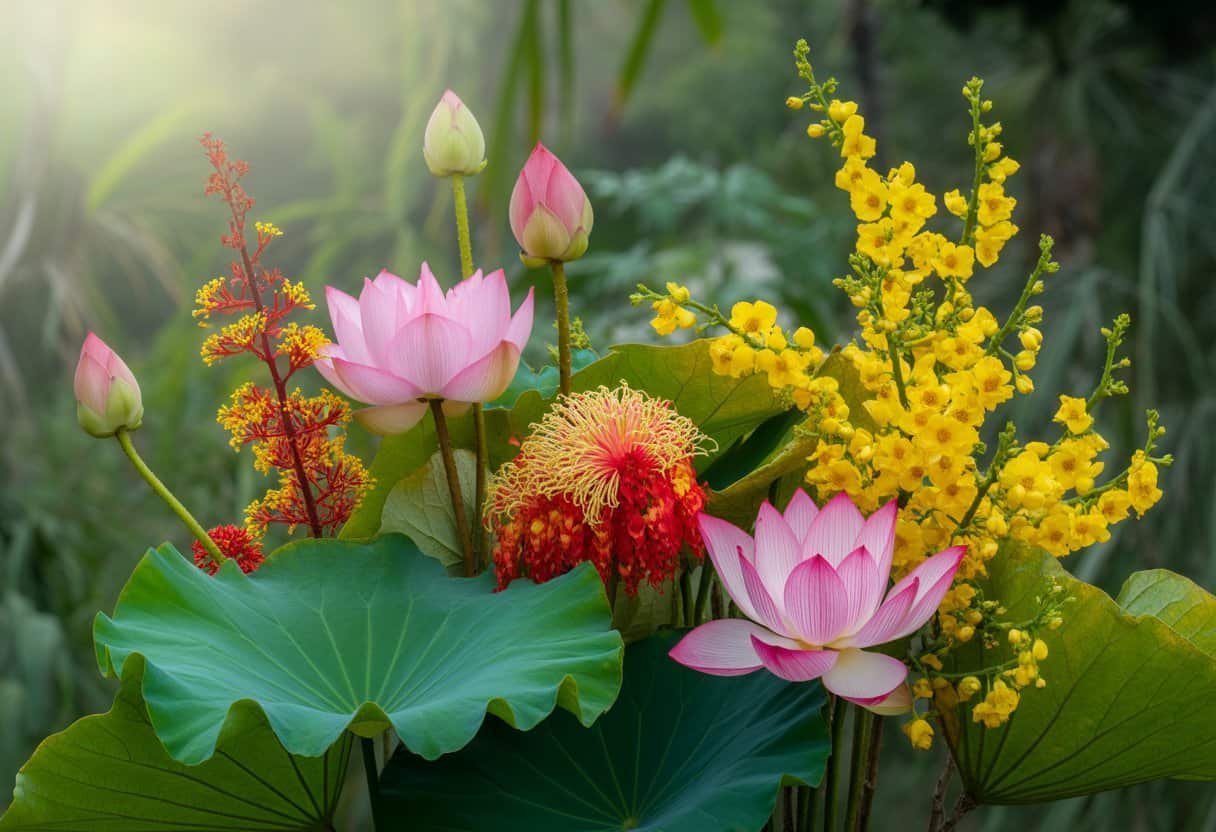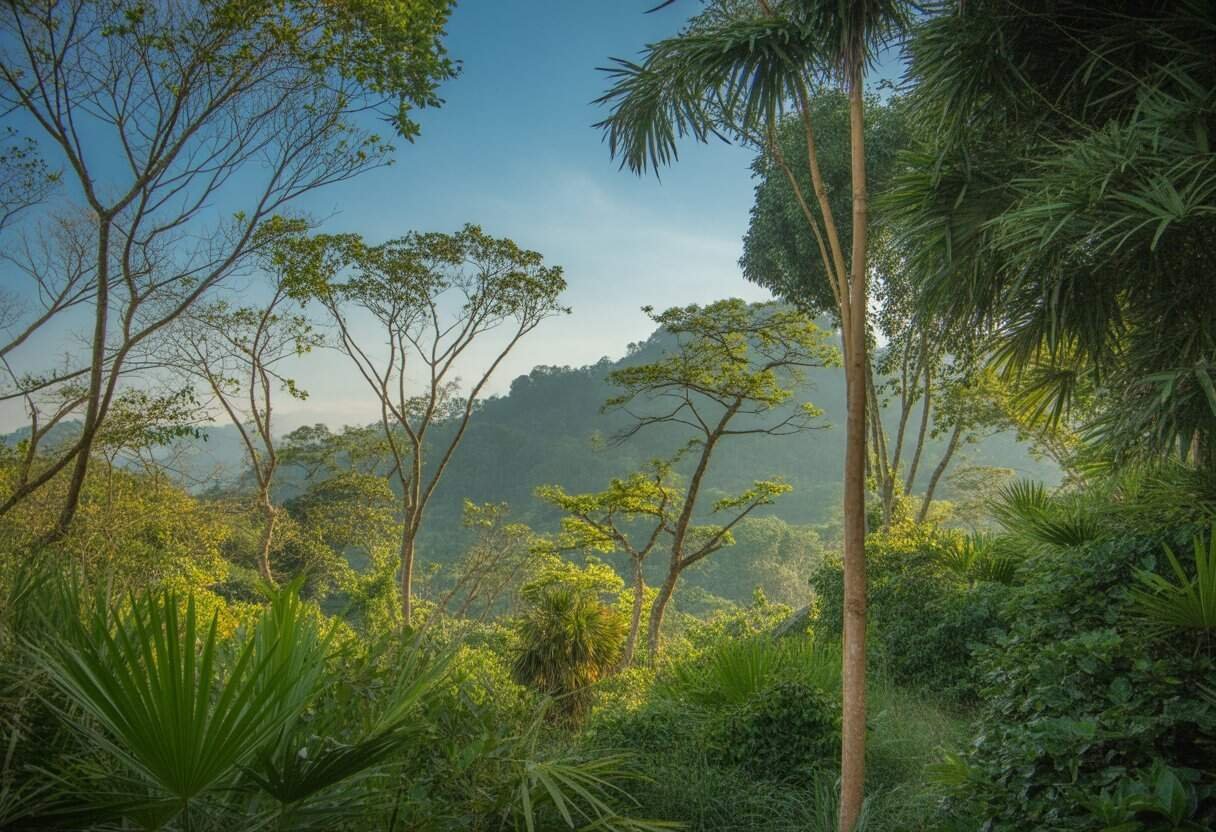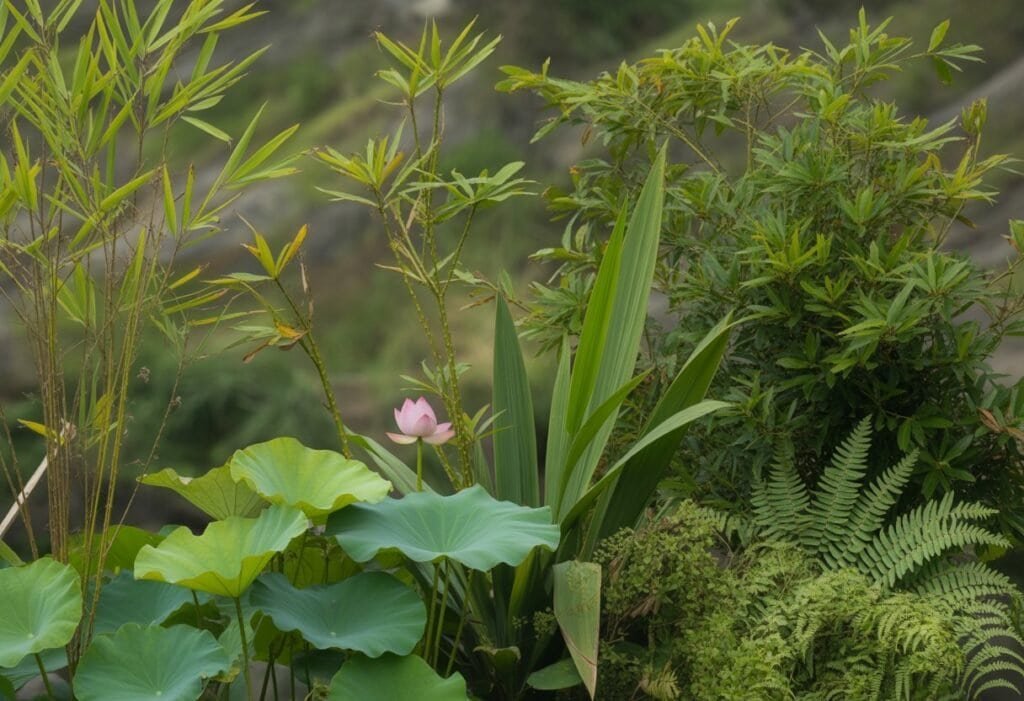Vietnam’s rich biodiversity includes thousands of native plant species that thrive in its diverse ecosystems. From the northern highlands to the Mekong Delta, these plants have adapted to varied climates and terrains.
Native Vietnamese plants play crucial roles in local ecosystems and have significant cultural importance in traditional medicine, cuisine, and religious practices.

Many of Vietnam’s native plants are endemic, meaning they grow naturally only in this region of Southeast Asia. The country’s location in the Indo-China peninsula creates perfect conditions for tropical and subtropical species.
Vietnam’s rainforests, mountains, and wetlands all support unique plant communities that have evolved over thousands of years.
Key Takeaways
- Vietnam hosts over 10,000 native plant species across its diverse ecosystems from mountains to coastal areas.
- Many Vietnamese plants serve dual purposes in traditional medicine and cuisine while holding cultural significance.
- Conservation efforts are essential as Vietnam’s rapid development threatens numerous endemic plant species.
Overview of Vietnam’s Native Flora
Vietnam’s rich plant diversity includes over 13,000 species across various ecosystems, from coastal mangroves to highland forests. This botanical wealth reflects the country’s varied topography, climate zones, and its position as a biogeographic crossroads in Southeast Asia.
Major Plant Groups
Vietnam hosts several distinct plant families and groups that define its landscapes. Dipterocarpaceae trees dominate many forests, with species like Dipterocarpus alatus providing valuable timber and resin.
Orchids represent another significant group, with over 1,000 species including the rare Paphiopedilum vietnamense endemic to limestone regions. These delicate plants often grow as epiphytes on other trees.
The Mekong Delta features water-loving plants such as lotus (Nelumbo nucifera) and water hyacinth. Bamboo varieties thrive throughout the country, with more than 100 species creating distinctive groves in mid-elevation areas.
Ferns and cycads add to the understory diversity, especially in humid forest environments. Conifers like Fokienia hodginsii grow at higher elevations where temperate conditions prevail.
Vietnam’s Unique Ecosystems
The northern highlands contain mixed evergreen forests with rhododendrons and magnolias that thrive in cooler temperatures. These forests support numerous medicinal plants used in traditional Vietnamese medicine.
Coastal mangrove forests serve as nurseries for marine life. Species like Rhizophora apiculata and Sonneratia alba have specialized root systems that withstand daily tidal flooding.
Limestone karst formations host plant communities adapted to minimal soil and water. These limestone forests feature many endemic species found nowhere else.
The central highlands support distinctive Dipterocarp forests and pine woodlands. This region serves as a biodiversity hotspot with unique flora adapted to the red basaltic soils.
Biodiversity and Endemic Species
Vietnam ranks among the world’s top 25 countries for plant diversity, with about 10% of its flora being endemic. The Hoang Lien Son range alone hosts over 2,000 plant species.
Several remarkable plants exist only in Vietnam, including Caryota urens (fishtail palm) and the recently discovered Thismia vietnamensis, a ghostly mycoheterotrophic plant that lives underground.
The limestone karsts of Ha Long Bay and northern Vietnam harbor many endemic species. These plants have adapted to extreme conditions with features for water conservation and nutrient acquisition.
Habitat loss and illegal harvesting put pressure on valuable species like Aquilaria crassna (agarwood), prized for its fragrant resin. Climate change also threatens Vietnam’s unique plant communities, especially in fragile mountain ecosystems.
Iconic Native Flowers of Vietnam

Vietnam’s diverse climate supports a variety of beautiful native flowers with cultural and historical significance. These flowers appear in art, literature, and traditional celebrations.
Lotus Flower (Hoa Sen)
The lotus flower (Hoa Sen) is Vietnam’s national flower and grows abundantly in ponds and lakes across the country. It rises from muddy waters to produce stunning pink and white blooms that symbolize purity, commitment, and optimism.
Vietnamese people value the lotus for its usefulness. The petals, seeds, stems, and roots all serve practical purposes.
The seeds and roots appear in traditional dishes, while the petals often flavor tea. In Buddhism, the lotus represents enlightenment and spiritual awakening.
Many temples and pagodas feature lotus designs in their architecture and decorations. The flower appears on currency, in poetry, and as decorative motifs throughout Vietnamese culture.
Orchids
Orchids thrive in Vietnam’s tropical climate, with over 300 native species growing throughout the country. These elegant flowers range from tiny blooms to large, showy blossoms in various colors and patterns.
Wild orchids grow in Vietnam’s forests, while cultivated varieties appear in gardens and homes. Many Vietnamese believe orchids bring good fortune and prosperity to households.
The most famous Vietnamese orchids include:
- Dendrobium orchids with their clustered blooms
- Paphiopedilum (lady slipper) orchids with their distinctive pouch-like petals
- Cymbidium orchids prized for their long-lasting flowers
In Vietnamese poetry and art, orchids often symbolize refinement, beauty, and academic achievement. Many orchid festivals celebrate these beloved flowers, especially in mountain regions.
Apricot Blossom and Peach Blossom
Apricot blossoms (Hoa Mai) and peach blossoms (Hoa Đào) hold special significance during Tet, the Vietnamese New Year. Yellow apricot blossoms dominate southern celebrations, while pink peach blossoms appear more commonly in northern regions.
Vietnamese families carefully time these trees to bloom during Tet, as the flowers symbolize prosperity and new beginnings. Apricot blossoms represent wealth and good fortune with their golden color.
Peach blossoms are believed to ward off evil spirits and bring happiness to households. Their delicate pink petals appear on greeting cards, decorations, and in paintings during the holiday season.
These blossoms last only briefly but create a stunning display that marks the arrival of spring. Their appearance in homes signals readiness for the new year.
Rose and Da Lat Rose
Roses hold special significance in Vietnam, especially those grown in Da Lat, a city in the Central Highlands known as “The City of Eternal Spring.” Da Lat’s cool climate provides ideal conditions for growing roses year-round.
Da Lat roses are famous for their:
- Vibrant colors and large blooms
- Strong fragrance
- Remarkable longevity after cutting
- Variety (over 300 types cultivated)
These roses have become symbols of romance and love in Vietnamese culture. Young couples often exchange Da Lat roses as tokens of affection.
Da Lat’s rose gardens attract thousands of tourists annually. The city hosts flower festivals where elaborate rose displays showcase the region’s horticultural expertise.
Trees Native to Vietnam’s Landscapes

Vietnam’s diverse climate supports a rich variety of native trees across its landscapes, from dense tropical forests to coastal regions. These trees play vital roles in local ecosystems and have significant cultural and economic importance.
Tropical Hardwood Trees
Vietnam’s forests host several valuable hardwood species prized for their durability and beauty. The teak tree (Tectona grandis) grows in the northern regions and provides water-resistant timber used in shipbuilding and furniture.
The kapok tree (Ceiba pentandra) reaches heights of up to 70 meters, featuring a straight trunk and umbrella-shaped crown. Its cotton-like fiber has been harvested for stuffing pillows and life preservers.
Indian milkwood (Alstonia scholaris) grows abundantly in lowland forests. Local communities use its bark for traditional medicines to treat fever and respiratory conditions.
These hardwood species face threats from deforestation but remain important in forest conservation efforts.
Fruit-Bearing Species
Jackfruit trees (Artocarpus heterophyllus) thrive in Vietnam’s tropical climate, producing the world’s largest tree fruit weighing up to 35 kg. The jackfruit provides both sweet fruit and timber for furniture making.
Mango trees (Mangifera indica) grow throughout Vietnam, with over 40 varieties cultivated across the country. The fruit appears in many Vietnamese dishes and desserts.
Papaya trees (Carica papaya) produce year-round in Vietnam’s tropical climate. Their quick growth and continuous fruiting make them valuable for small-scale farmers.
The tamarind tree (Tamarindus indica) yields tart pods used in Vietnamese cooking. Its shade-giving properties make it common in village gathering places.
Persimmon trees (Diospyros kaki) grow mainly in northern highlands, producing sweet orange fruits that are often dried for preservation.
Ornamental and Shade Trees
Phoenix flower trees (Delonix regia) create spectacular displays with their red-orange blossoms that cover the tree from April to June. These trees line many urban streets in Vietnam.
Rose myrtle (Rhodomyrtus tomentosa) grows as a small ornamental tree with pink flowers and purple berries. Local communities use these berries to produce rose myrtle wine, a specialty of mountainous regions.
Traveller’s palm (Ravenala madagascariensis), though not a true palm, belongs to the bird-of-paradise family. Its fan arrangement makes it popular in landscaping.
The tropical almond (Terminalia catappa) provides excellent shade with broad leaves that turn red before falling. Children collect the nuts for snacks, while the leaves and bark have traditional medicinal uses.
Coastal and Mangrove Trees
Coconut palms (Cocos nucifera) define Vietnam’s coastlines, providing fruit, building materials, and protection against coastal erosion. Every part of this tree serves a purpose in village life.
Casuarina trees (Casuarina equisetifolia) create natural windbreaks along Vietnam’s coastline. Their salt tolerance and deep roots help stabilize beach dunes and protect inland areas.
Vietnam’s mangrove forests contain specialized trees adapted to brackish environments. These trees develop breathing roots and salt-filtering systems to survive in tidal zones.
Dragon fruit trees (Hylocereus undatus) grow successfully in sandy coastal soils. Though technically a climbing cactus, these plants are often trained as small trees in coastal plantations.
Distinctive Native Shrubs and Bushes
Vietnam’s diverse climate supports a variety of unique shrubs and bushes that thrive in its tropical and subtropical regions. These plants play important roles in local ecosystems and many have been used traditionally by Vietnamese people for centuries.
Flowering Shrubs
Rose myrtle bush (Rhodomyrtus tomentosa) grows abundantly in Vietnam’s highlands, displaying pink flowers and fuzzy leaves. This hardy shrub reaches 1-2 meters in height and produces edible berries.
Lantana plants grow in Vietnam’s coastal areas, featuring clusters of small, colorful flowers that attract butterflies. Although considered invasive in some regions, lantana remains an important nectar source for pollinators.
Ixora, commonly called jungle flame, has dense clusters of star-shaped flowers in red, orange, or yellow. This evergreen shrub grows well in Vietnam’s humid conditions and often appears in garden hedges.
Madagascar periwinkle (Catharanthus roseus) flourishes in Vietnam’s sunny locations. This small shrub produces pink or white flowers year-round and has become important in modern medicine.
Hibiscus shrubs display large, showy flowers in various colors throughout Vietnam. Many Vietnamese gardens feature hibiscus for its ornamental value and cultural significance.
Medicinal and Edible Shrubs
Yellow oleander (Cascabela thevetia) grows throughout Vietnam’s warmer regions. Though toxic if used incorrectly, traditional healers have used specific parts in controlled preparations for heart conditions.
Indian milkwood pine (Alstonia scholaris) is valued for its medicinal bark. The bitter extract treats fever and digestive issues.
Periwinkle shrubs contain compounds used to treat diabetes in folk medicine. Recent research shows these plants contain alkaloids that help regulate blood sugar levels.
Many Vietnamese households grow medicinal shrubs in home gardens. These plants provide remedies for common ailments and supplement the family’s diet.
Rose myrtle fruits are collected from wild bushes and used in jams or eaten fresh. The berries have high levels of antioxidants and a sweet-tart flavor.
Native Vines and Groundcovers
Vietnam’s diverse climate supports many native vines and groundcovers. These plants add beauty to gardens and adapt well to local conditions.
They provide excellent options for sustainable landscaping projects.
Flame Vine and Related Species
Flame Vine (Pyrostegia venusta) thrives in Vietnam’s tropical climate. It displays vibrant orange-red tubular flowers that attract pollinators.
This fast-growing climber can reach up to 40 feet in length. It is ideal for covering walls and trellises.
Bougainvillea, now naturalized in Vietnam, features paper-like bracts in stunning colors such as purple, red, orange, and white. It needs minimal water once established and flourishes in sunny conditions.
Porcelain Flower (Hoya carnosa) is one of Vietnam’s prized native vines. This evergreen climber produces clusters of star-shaped, waxy flowers with a sweet fragrance, especially at night.
Vietnamese gardeners often grow it in hanging baskets. Others let it climb indoor supports.
Other Ornamental Groundcovers
Vietnam’s native groundcovers offer practical alternatives to traditional lawns. Many need less maintenance than introduced species like carnations and tulips.
Common Native Groundcovers:
- Chrysanthemum indicum (wild chrysanthemum)
- Asystasia gangetica (Chinese violet)
- Wedelia trilobata (Singapore daisy)
Wild chrysanthemum forms mats of foliage topped with yellow daisy-like flowers. The native variety resists local pests and requires no special care.
Vietnamese gardens often include these groundcovers with ornamental plants from other regions. This combination creates sustainable landscapes that celebrate native biodiversity and global garden traditions.
Groundcovers help prevent soil erosion in Vietnam’s rainy climate. They also provide habitat for beneficial insects that control garden pests.
Aquatic and Wetland Plants of Vietnam
Vietnam’s water ecosystems support a rich variety of aquatic and wetland plants. These plants help filter water and provide habitat for wildlife.
They also hold cultural significance in Vietnamese traditions.
Lotus and Water Lily Varieties
The lotus flower (Nelumbo nucifera) is Vietnam’s national flower. It thrives in ponds and produces large pink or white blooms that rise above the water.
Vietnamese people use every part of the lotus plant. The seeds make nutritious snacks, and the stems appear in many salads.
The large leaves serve as natural wrapping for food. Lotus tea, made from dried stamens, has a delicate flavor and pleasant aroma.
Many Vietnamese enjoy this fragrant drink for its calming properties. Water lilies (Nymphaea species) create colorful displays in Vietnam’s waterways.
Water lily blooms float directly on the water’s surface. These plants help maintain water quality by absorbing excess nutrients.
Wetland Habitats
Vietnam’s wetlands cover about 1.2 million hectares. The Mekong Delta region contains the country’s largest wetland ecosystem.
Mangroves form protective barriers along coastal areas. Their roots filter saltwater and prevent erosion.
These trees provide nursery grounds for fish and other marine life. Reeds and rushes grow abundantly in freshwater marshes.
Local communities harvest these plants to create traditional crafts like baskets and mats. Water spinach (Ipomoea aquatica) grows in shallow wetlands and is a popular vegetable in Vietnamese cuisine.
This fast-growing plant contains high levels of vitamins A and C. Papaya trees often grow near wetland edges where soil stays moist but not saturated.
Their proximity to water sources helps them grow steadily.
Native Plants in Vietnamese Traditions
Plants native to Vietnam play important roles in cultural traditions and celebrations. They appear in folklore, religious ceremonies, and everyday customs that shape Vietnamese identity.
Cultural Symbolism of Native Flora
Bamboo represents resilience and strength in Vietnamese culture. Its ability to bend without breaking symbolizes the Vietnamese spirit during hardship.
People admire bamboo for its straightforward growth and practical uses in daily life. The lotus flower holds special significance as Vietnam’s national flower.
It grows from muddy waters yet produces beautiful, clean blooms. This transformation symbolizes purity and spiritual enlightenment in Buddhist traditions.
Hoa Dao (peach blossoms) represent good fortune and new beginnings. Families display these pink flowers in northern Vietnam during Tet Holiday to invite prosperity.
Apricot blossoms serve as the southern equivalent to peach blossoms. Their golden-yellow color symbolizes wealth and happiness for the new year.
Role in Festivals and Holidays
During Tet Holiday, Vietnam’s most important celebration, native plants decorate homes and public spaces. Families select flowering trees and plants to bring blessings for the new year.
Kumquat trees with small orange fruits represent fertility and abundance. The more fruit the tree bears, the more prosperity it promises.
Marjoram, basil, and perilla appear in special Tet dishes. These aromatic herbs connect holiday meals to agricultural traditions.
Rice plants feature in harvest festivals throughout Vietnam. Communities celebrate successful harvests with ceremonies that honor these vital plants through dance and song.
Native flowers also appear in festivals celebrating love and beauty. Young people exchange flowers as tokens of affection.
Conservation and Future of Vietnam’s Native Plants
Vietnam’s unique flora faces significant challenges. Conservation efforts aim to protect these botanical treasures while balancing economic development and environmental protection.
Threats to Native Flora
Vietnam’s native plants face severe threats from deforestation and habitat loss. About 100,000 hectares of forest disappear each year, mainly affecting tropical hardwood trees like Dalbergia tonkinensis.
These timber species are harvested faster than they can regenerate. Climate change brings new challenges, especially in the Mekong Delta where rising sea levels change growing conditions for native species.
Salt water intrusion damages natural ecosystems and alters soil composition. Illegal wildlife trade also targets rare orchids and medicinal species.
Agricultural expansion for crops like pepper often replaces natural habitats with monocultures. Urban development fragments remaining habitats, reducing genetic diversity and weakening plant populations.
Conservation Initiatives
Vietnam has established 30 national parks and many nature reserves to protect native flora. These protected areas cover about 2.2 million hectares and safeguard critical habitats.
The Vietnam Plant Conservation Action Plan identifies priority species and regions for protection. This program preserves genetic diversity through seed banking and botanical garden collections.
Key Conservation Projects:
- Hoang Lien Son Biodiversity Project (alpine species)
- Cat Tien National Park rare plant restoration
- Bach Ma Biodiversity Conservation initiative
- Mekong Delta wetland ecosystem protection
International partnerships with organizations like IUCN and WWF provide support. These collaborations strengthen local conservation through training and research.
Community-based conservation involves local villages in forest management. This approach values traditional knowledge and provides economic incentives for protection.
Sustainable Utilization and Protection
Sustainable harvesting guidelines for valuable plants help balance conservation and livelihoods. For example, regulated wild pepper collection lets communities benefit while maintaining natural populations.
Ecotourism focused on botanical attractions creates economic value for intact ecosystems. Visitors to places like Cuc Phuong National Park generate income that supports conservation.
Ethnobotanical knowledge preservation programs document traditional plant uses. These initiatives help value native flora and encourage protection.
Sustainable Plant Programs:
| Initiative | Focus Area | Impact |
|---|---|---|
| Forest Certification | Timber species | Reduced illegal logging |
| Medicinal Plant Cultivation | Traditional herbs | Less wild harvesting |
| Native Species Nurseries | Reforestation | Habitat restoration |
Research into climate-resilient native plants helps adaptation strategies. Scientists identify species that can withstand changing conditions in vulnerable areas like the Mekong Delta.
Education programs raise awareness about Vietnam’s botanical heritage. These efforts build public support for conservation and inspire future plant scientists.
Frequently Asked Questions
Vietnam’s diverse climate creates ideal conditions for many plant species. The country’s geography, from mountains to coastal regions, supports a rich variety of native flora that grows in the wild and in cultivation.
What are some common outdoor plants that originate from Vietnam?
Vietnam is home to many outdoor plants that thrive in tropical and subtropical conditions. The Bird of Paradise (Strelitzia) with its orange and blue flowers grows well in Vietnam’s climate.
Bamboo varieties, especially Bambusa vulgaris, are abundant throughout the country. These fast-growing plants serve both decorative and practical purposes.
Vietnamese honeysuckle (Lonicera japonica) grows widely as a climbing vine with fragrant flowers. It adapts to various soil conditions and provides habitat for local wildlife.
Can you list typical indoor plants that are native to Vietnam?
Several Vietnamese native plants make excellent houseplants. The Peace Lily (Spathiphyllum) thrives in Vietnam’s forests and adapts well to indoor environments with its glossy leaves and white flowers.
Dracaena plants, especially Dracaena sanderiana (Lucky Bamboo), come from Vietnamese tropical forests. These plants need minimal care and can grow in water or soil.
Vietnamese Rubber Plants (Ficus elastica) have broad, glossy leaves and tolerate indoor conditions well. They grow as tall trees in the wild but stay manageable indoors.
Which flowers are considered endemic to Vietnam?
The Dalat Rose (Rosa gigantea) grows naturally only in Vietnam’s highlands. These large roses have pale pink to white blooms and a distinctive fragrance.
Rhododendron simsii varieties grow only in Vietnam’s northern highlands. Their vibrant blooms appear in red, pink, and white clusters during spring.
The Ha Long Orchid (Paphiopedilum helenae) grows only in limestone formations in northern Vietnam. This rare orchid has delicate yellow flowers with red markings.
What are the most prevalent tree species found in Vietnam?
The Water Coconut Palm (Nypa fruticans) dominates Vietnam’s coastal and delta regions. These trees provide food, building materials, and help prevent soil erosion.
Vietnamese Teak (Tectona grandis) grows extensively in the central highlands. Its durable wood has been used for centuries for furniture and construction.
Banyan trees (Ficus benghalensis) grow throughout Vietnam and often reach massive sizes. Their aerial roots create distinctive structures that hold cultural significance in many villages.
What is the designated national symbol of Vietnam?
The bamboo plant serves as Vietnam’s unofficial national plant symbol. Bamboo represents resilience, strength, and adaptability in Vietnamese culture.
Vietnamese people see bamboo as a symbol of the human spirit—straight, simple, pure, yet flexible and useful. The plant appears in folktales, poems, and paintings.
Bamboo has practical uses in construction, crafts, and cooking. It has been central to Vietnamese daily life for centuries.
What is the iconic flower known to represent Vietnam?
The lotus flower (Nelumbo nucifera) represents Vietnam’s cultural identity. This aquatic plant grows in ponds throughout the country.
Vietnamese people admire the lotus for emerging clean and beautiful from muddy waters. This symbolism appears in Buddhist teachings and Vietnamese poetry.
The lotus appears in Vietnamese architecture and art. People also use it as decoration during festivals.
Different parts of the plant serve culinary purposes. Vietnamese cuisine uses lotus seeds, stems, and roots in traditional dishes.


